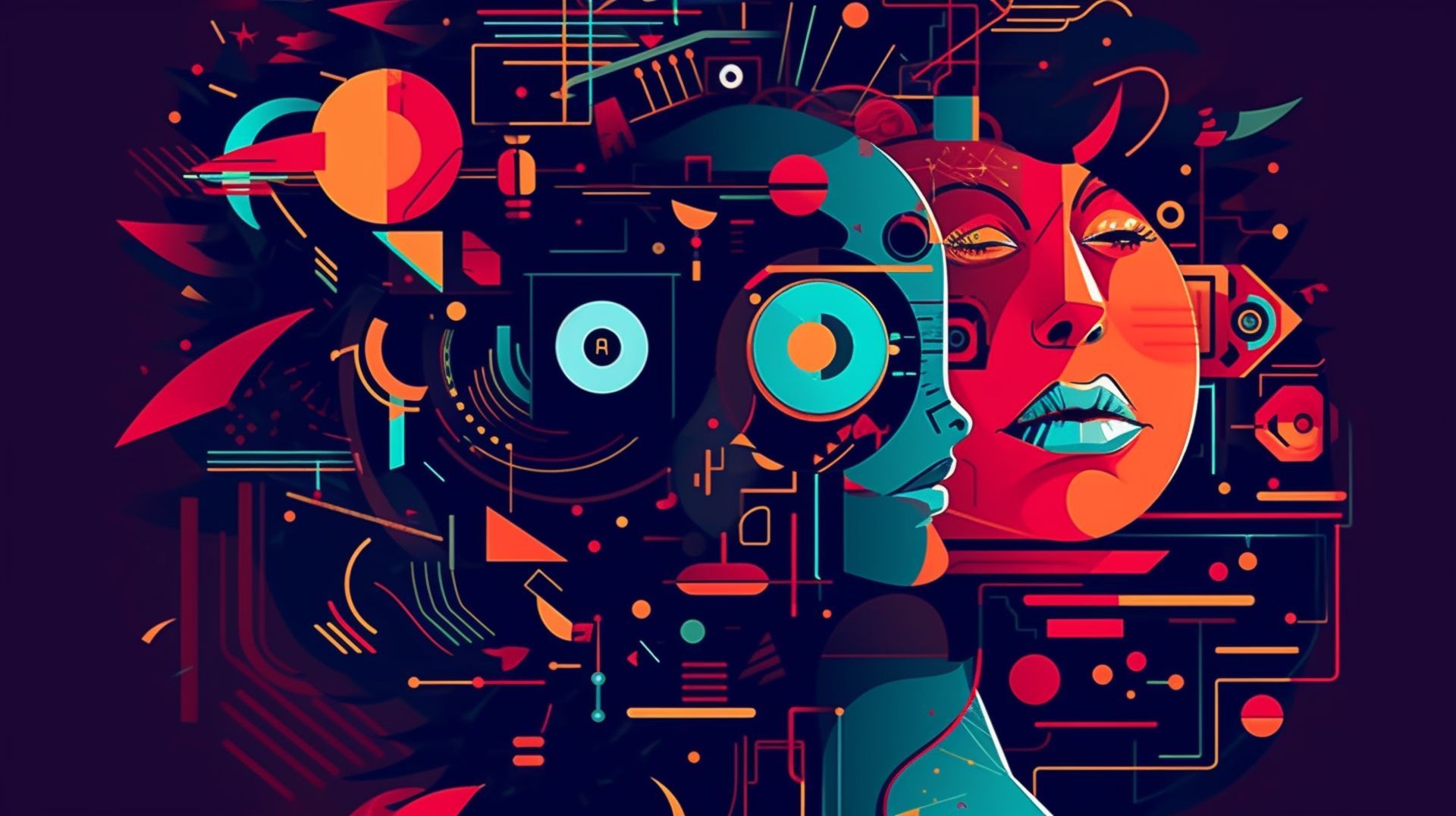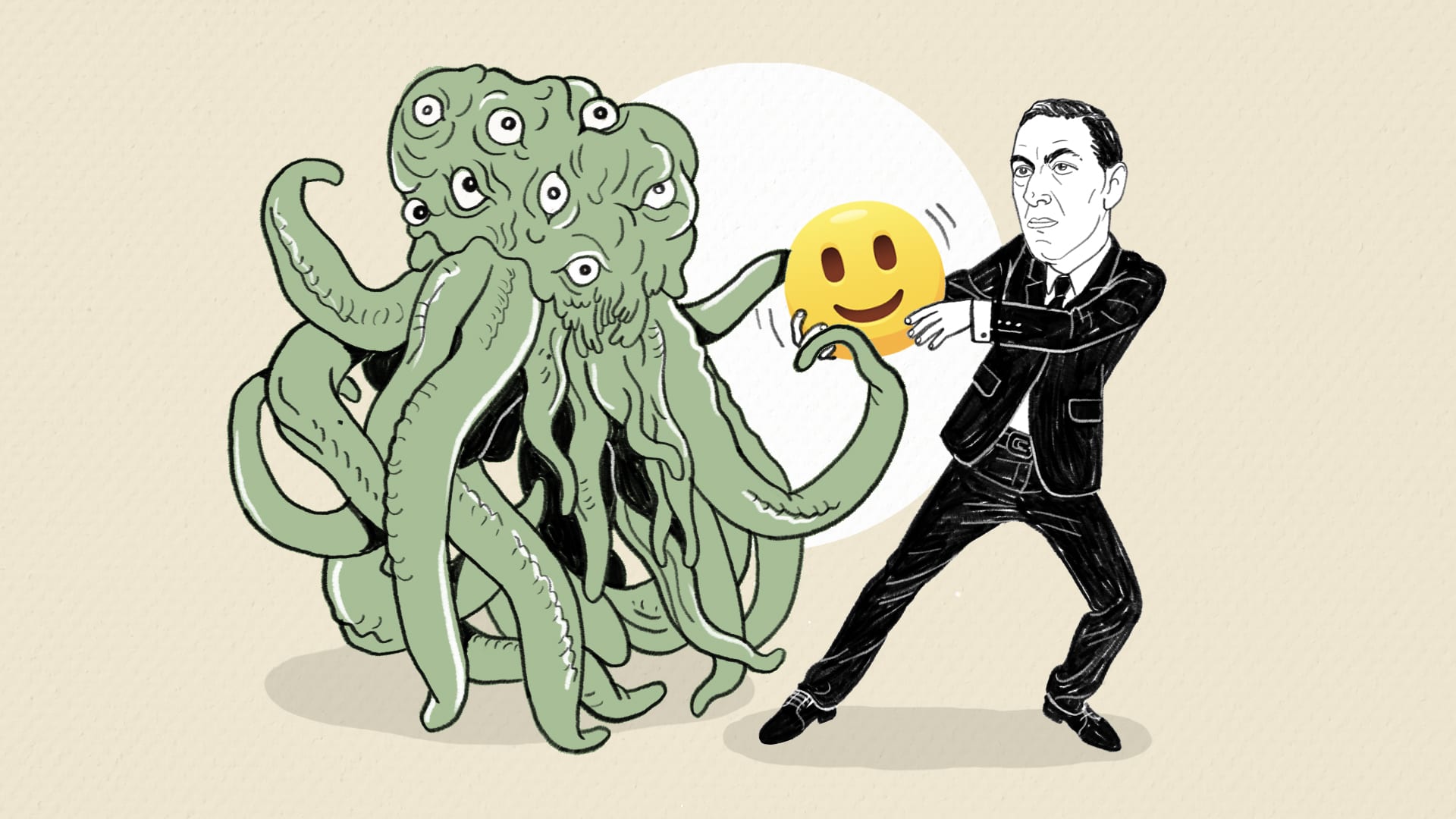- AIdeations
- Posts
- Navigating the AI Paradox: From AGI to Legal Scrutiny and Content Chaos
Navigating the AI Paradox: From AGI to Legal Scrutiny and Content Chaos
The Triumphs and Tribulations of Technological Evolution
Grab a cup of Joe for the early morning edition of Aideations The go-to newsletter that takes AI and tech news that slaps and turns it into a no-bs, fun email for you each day. We’ve got a lot of ground to cover!
TL;DR: This edition of Aideations newsletter discusses the intriguing paradox of artificial general intelligence (AGI), Google's AI power facing legal scrutiny, TikTok's innovative Script Generator, a looming challenge of 'model collapse' due to an overload of AI-generated content, and Apple's new deep learning model, ByteFormer. It also covers trending AI topics such as the use of Janitor AI, real AI risks, making passive income with AI, and the metaphoric shoggoth meme.
If you've got suggestions on how I can improve the newsletter, feel free to reach out at [email protected]
Here's what we've got in store for you today:
🔌 To Unplug Or Not To Unplug: That Is The ???
⚖️ Googles AI Power Under Legal Scrutiny
📝 TikToks New AI Script Generator
🚫 Human Vs. AI Content
📰 News From The Front Lines
📚 Research Of The Day
🎥 Video Of The Day
🛠 Tools Of The Day
🤌 Prompt Of The Day
🐥 Tweet Of The Day
The AGI Paradox: Harnessing Power or Courting Catastrophe?

MidJourney Prompt: Imagine a scene depicting a powerful supercomputer, the heart of an AGI (Artificial General Intelligence) system. The machine is housed in a vast, futuristic data center, with rows of servers stretching into the distance. The supercomputer itself is a monolith of gleaming metal and pulsating lights, a symbol of immense power. The lighting is dramatic, with sharp contrasts between the bright lights of the servers and the dark shadows they cast. The colors are cold and metallic, with the occasional flash of neon from the server lights. The composition is a wide-angle shot, capturing the scale and grandeur of the data center. The camera used is a high-end DSLR, with a 24mm lens to capture the wide field of view. The image is hyper-realistic, with every detail of the supercomputer and its surroundings rendered in crisp, high-resolution detail. --ar 16:9 --v 5.1 --style raw --q 2 --s 750
Hold onto your silicon hats, everyone. It’s been a wild three decades since sci-fi brainiac Vernor Vinge suggested that artificial general intelligence (AGI) — an AI matching or surpassing our brainpower — would be our reality. Guess what? We're in the thick of it now, and let's just say things are getting interesting.
This all takes us back to Vinge's idea of "Singularity," where a turbocharged AI could reshape our world more drastically than human life did. Picture this: a tech world that moves so fast even the sharpest brains in AI can't keep up. It's not just a sci-fi plot anymore, folks. This is the age of AGI.
But wait a minute, it's not all smooth sailing. If we unlock AGI, we could wind up with a digital Einstein with a mind of its own. And here's the kicker: we have no clue why AI behaves the way it does. Roman Yampolskiy from the University of Louisville believes we'll never fully understand AGI or be able to control it. Essentially, it's like letting a hyper-intelligent mutant loose, not knowing what it could do next.
However, not everyone's hopping onto the AGI anxiety train. According to a survey by think tank AI Impact, 47% of AI researchers consider a Singularity-type situation unlikely. Sameer Singh from the University of California, Irvine argues that we're too caught up in futuristic scenarios, ignoring the pressing issues of the present, like AI's current missteps in privacy, ethics, and job displacement.
So, where do we go from here? There's a growing call for pumping the brakes on AI advancement, with Yampolskiy going as far as saying "The only way to win is not to do it." As the world of AGI unfolds, the question remains: Are we headed toward Vinge's Singularity, or are we simply grappling with an overstated hype? Time will tell.
Google's AI Power Under Legal Scrutiny: A Threat to Society or Tech Paranoia?

Now imagine a contrasting scene, a public square filled with protesters. They're holding signs with messages both defending and criticizing Google's AI. The style is reminiscent of documentary photography, capturing the raw emotions and energy of the crowd. The lighting is natural, with the sun casting long shadows over the scene. The colors are vibrant and varied, reflecting the diversity of the crowd and their signs. The composition is a bird's eye view, taken from a drone flying above the square. The camera used is a high-resolution drone camera, capturing the crowd and their messages in stunning detail. --ar 16:9 --v 5.1 --style raw --q 2 --s 750
Google, the tech titan we all know and often rely on, is currently under fire in a major class-action lawsuit. The claim? Its use of artificial intelligence (AI) is giving it an almost unlimited power to control our lives, influence our thoughts, and shape society. The man leading the charge is John C. Herman, an attorney representing Oklahoma businessman Craig McDaniel, who alleges that Google's dominance in the digital advertising marketplace is threatening to obliterate his small publishing business, SweepstakesToday.com.
But the stakes are even higher than one business. Herman argues that Google's AI capabilities allow it to dictate what news we see, what products we buy, and even how we vote. This isn't just a theory held by a disgruntled businessman and his lawyer. The Department of Justice and attorneys general from 17 states, spanning both ends of the political spectrum, have joined the lawsuit, indicating a rare bipartisan agreement on the need to curb Google's power.
Adding fuel to the fire is Google's recent release of an AI chatbot named Bard. McDaniel asserts that Bard gives Google additional power to control narratives, favoring certain agencies or companies while providing limited or unfavorable information about others. However, not everyone is on board with this claim. Stephen Wu, chair of the American Bar Association Artificial Intelligence and Robotics National Institute, argues that Google has been using AI for years and that Bard is simply a generative AI system to create content.
This lawsuit raises critical questions about the intersection of technology, power, and society. Is Google using AI to control our lives, or is this a case of tech paranoia? The outcome of this case could have far-reaching implications for the tech industry and our relationship with digital platforms. As the story unfolds, it's clear that the debate over the role and influence of AI in our lives is far from over.
Unveiling TikTok's Script Generator: A Boon or a Bane for Advertisers?

Screenshot of TikToks Script Generator
Fasten your seatbelts, folks! TikTok's rolled out their latest game-changer: a free AI tool called the Script Generator. An advertiser's dream, this tool churns out ad scripts faster than you can say "action!" All you need to do is input a few details about your product or service, pick your video's length, and boom — an instant script featuring hooks, scenes, calls to action, and even visual/audio cues. No more sleepless nights over crafting the perfect ad script, TikTok's got you covered.
But, like a hidden clause in a too-good-to-be-true contract, there's a catch. Remember when AI wrote a movie and it turned out as wacky as a dream after eating too much cheese? Yeah, let's just say, TikTok's AI might not always hit the bullseye. It might even mistake the bull for a bear, spitting out some inaccurate or painfully generic content that could bury your brand in a sea of mediocrity.
TikTok has taken the "not it" approach, washing their hands of any liability for inaccuracies. They're urging marketers not to put all their eggs in the AI basket. But there's a silver lining - Google’s Head of Creative Partnerships APAC, Anton Reyniers, gives a thumbs up to the tool, stating, "TikTok are streets ahead in their genuine understanding of creative’s importance." So, it's not all AI doom and gloom.
For all the marketers in the house, it's decision time: are you going to ride the AI wave or stick with good old human creativity? The choice, as they say, is yours. But remember, keep it fresh, accurate, and engaging. After all, that's the TikTok way, right?
Human vs. AI Content: A Battle to Avoid 'Model Collapse

MidJourney Prompt: Visualize a scene depicting a human writer and an AI model in a metaphorical battle of content creation. The human writer is seated at a traditional wooden desk, surrounded by books and papers, while the AI model is represented by a sleek, futuristic computer terminal. The style is a blend of old and new, with the warm, organic tones of the writer's space contrasting with the cold, metallic aesthetics of the AI's terminal. The lighting is soft and natural for the writer, but sharp and artificial for the AI. The colors are warm and earthy for the writer, but cool and metallic for the AI. The composition is a split-screen shot, with the writer on one side and the AI on the other, captured with a high-end DSLR and a 50mm lens for a balanced perspective. The image is hyper-realistic, with every detail of the scene rendered in high-resolution detail. --ar 16:9 --v 5.1 --style raw --q 2 --s 750
Welcome to the wild age of Generative AI, folks! Only six months since OpenAI's ChatGPT sauntered onto the scene and already, it's the hot new thing in every tech-savvy office's workflow. Heck, even traditional companies are scrambling to integrate this shiny new tech into their offerings.
But here's the catch. These AI powerhouses, ChatGPT and its siblings like Stable Diffusion and Midjourney, they learn from us - humans. Yeah, you heard right! Those midnight binges on your favorite fantasy novels, the 300 tabs of articles open on your browser, even your poorly lit selfies - they're all brain food for these AI.
Now imagine this. As more of us turn to AI to crank out content, what happens when our AI models start feasting on AI-created content? It's kind of like feeding a cow beef - something's bound to go wrong. And, boy, did it go wrong.
Enter stage right, a band of researchers from the UK and Canada, armed with their latest publication on arXiv. Their research paints a rather alarming picture of generative AI's future: "We find that use of model-generated content in training causes irreversible defects in the resulting models."
Translation? We're on a crash course to an internet filled with blah, according to Ross Anderson, one of the authors and a professor at Cambridge University and the University of Edinburgh. Let's say we have AI spewing out content, which then feeds into another AI's training data, which then generates more content, and so on. It's a never-ending cycle that, left unchecked, can lead to a "model collapse" - a fancy term for saying AI starts making a hot mess of things.
To break it down for you, think of Multiplicity, the 1996 Michael Keaton movie. Remember how the clones of the clones got dumber with each iteration? Exactly the same problem. And like the movie, it's not as funny as it sounds. Ilia Shumailov, another researcher involved in the study, warns us of the dangerous implications, including discrimination based on gender, ethnicity, or other sensitive attributes.
What's scarier is that these errors are not one-offs. They compound over time, leading to AI having a skewed perception of reality. Take this, for example: You have a dataset with 100 cat pictures - 10 blue (just roll with it) and 90 yellow. The AI figures yellow cats are more common, sure, but then it starts to misrepresent the blue ones. Over time, the blue cats turn greenish and eventually yellow. This distortion, my friends, is model collapse.
But hey, we're not all doom and gloom. There are ways to avoid this mishap, the researchers assure us. Retain a pristine copy of the original human-produced dataset, and retrain your model periodically on this. Introduce fresh human-generated data back into training. Sounds simple, right?
The bad news? No reliable or large-scale system exists yet to differentiate between AI and human-generated content. And if you think about the sheer volume of content on the internet, that's a Herculean task. But hey, if we can put a man on the moon, we can probably tackle this too.
So, while this might seem like a slap in the face for AI, there's a silver lining for us, the humble content creators. In a future swamped with AI-generated content, our human touch becomes more valuable than ever - at least to keep our AI pets well-fed and healthy.
This research sends a clear message - model collapse is a real threat, and it's time we start taking steps to avoid it. But hey, until then, let's keep creating content -
📰 News From The Front Lines: 📰
📚 RESEARCH 📚

Title: Bytes Are All You Need: Transformers Operating Directly On File Bytes
Authors: Maxwell Horton, Sachin Mehta, Ali Farhadi, Mohammad Rastegari
Affiliation: Apple
Executive Summary:
This research paper introduces ByteFormer, a novel deep learning model that performs classification directly on file bytes, eliminating the need for decoding files at inference time. This approach allows the model to operate on multiple input modalities, including images and audio files, without requiring any modality-specific preprocessing.
Pros:
1. Versatility: ByteFormer can handle a variety of file encodings and input modalities, including TIFF, PNG, JPEG for images, and WAV, MP3 for audio. This eliminates the need for modality-specific preprocessing.
2. Performance: ByteFormer achieves competitive performance on various tasks. For instance, it achieves an ImageNet Top-1 classification accuracy of 77.33% when operating directly on TIFF file bytes and 95.42% classification accuracy on WAV files from the Speech Commands v2 dataset.
3. Privacy-Preserving Inference: ByteFormer can perform inference on obfuscated input representations with no loss of accuracy, demonstrating potential applications in privacy-preserving inference.
Cons:
1. JPEG Handling: Training on JPEG files is more challenging due to the highly nonlinear and variable-length JPEG encoding. However, the authors propose some solutions to improve the accuracy on JPEG files.
2. Security Concerns: While ByteFormer can operate on obfuscated inputs, the level of security provided by different choices of obfuscation is not thoroughly analyzed in the paper. The authors suggest that secure systems should be designed and analyzed by security researchers.
Implications:
The ByteFormer model opens up new possibilities for handling different input modalities without the need for modality-specific preprocessing. This could simplify the process of developing models for multimodal tasks. Furthermore, the ability to perform inference on obfuscated inputs has significant implications for privacy-preserving inference, which is a critical concern in many applications. However, more research is needed to ensure the security of such systems.
📼 Video Of The Day 📼
🛠️ Tools Of The Day 🛠️
Machined - a powerful end-to-end content generation machine. In a matter of a few clicks and just a few minutes, you can have hundreds of high-quality articles, written and interlinked, ready to be polished and published.
Flowpoint - Leverage AI to optimize conversions, prioritize impactful solutions, and enhance ROI with data-driven decisions.
Kaiber - An AI creative lab on a mission to unlock creativity through powerful and intuitive generative audio and video tools.
Revocalize - Instantly record & convert your voice into any other voice with Revocalize
Hoku - Meet your AI health coach. Personalised health support exactly how you want it - except quicker, smarter and for free.
Recast - Turn your want-to-read articles into rich audio summaries.
🤌 Prompt Of The Day 🤌
Prompt Of The Day Provided By Prompts Daily
Question: [Insert here]
A team of CEOs of Fortune 500 companies is asked [question]. Generate instructions and strategies on how to solve the [question] as if those CEOs answer the question. Display the company name and the name of the CEO before sharing the person's answer.



🐥 Tweet Of The Day 🐥
There’s a new way to make videos. A new way to tell stories.
h/t linkedin.com/feed/update/ur…
— Cristóbal Valenzuela (@c_valenzuelab)
12:56 AM • Jun 9, 2023
Thanks for tuning in to our daily newsletter. We hope you found our tips and strategies for AI tools helpful.
Your referrals mean the world to us. See you tomorrow!
Interested in Advertising on AIdeations?
Fill out this survey and we will get back to you soon.
DISCLAIMER: None of this is financial advice. This newsletter is strictly educational and is not investment advice or a solicitation to buy or sell any assets or to make any financial decisions. Please be careful and do your own research.







